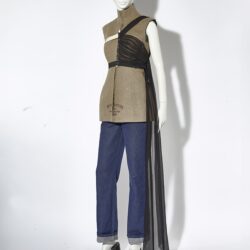Black as Mourning color: 5 did-you-knows about black

The colour black – dull, sheenless, lugubrious black – fits the bill perfectly as colour of choice for your mourning outfit on All Saints Day the 1st of November. Black has been around some time; in dark times it is the preferable shade to wear. We all tend to grab for a clothing item that doesn’t scream happiness when attending a funeral right? Well, unconsciously we are all being influenced by a long historic dress tradition. We happily give you a quick overview of 5 did-you-knows about black.
4 stages of Mourning
Mourning involved many rules. In 1876, Louis Mercier published Le Deuil, in which four stages of mourning were described, including which fabrics and shades must be worn and when. The First Stage lasted one year and one day – dressed in dull black wool bombazine trimmed with sheenless mourning crape. The Second Stage lasted nine months, still in sheenless, but with less crape. The Third Stage was ordinary mourning, which lasted three months in black silk, without crape and mourning jewellery. The Fourth Stage or half mourning lasted six months in which a wide variety of black, grey, white and mauve textiles were worn with mourning jewellery.
Sartorial errors
Mourning involved public appearances, both away from the home and when receiving condolences at home, with the bereaved family, including their servants, dressed in dull black. The complexity of dress etiquette that was required, caused a lot of stress for many middleclass women. So much so that the rules were explained repeatedly in women’s journals, such as English Women’s Domestic Magazine or La Belle Assemblée and in the USA in Godey’s Ladies Book, and Demorests Monthly. All published regular mourning dress advise and fashion plates and, from the 1850s, carried related advertisements. All of this was because many women were scared to make sartorial errors, in the belief to do so would bring public shame on their families.

The widower
The 19th century was not the first time men adopted black clothes, and it was not the first time it was a fashionable colour for men’s attire. The historic roots of men wearing black garments go back centuries. It had been a fashionable and stylish colour at several points throughout time. It’s reoccurrence over the centuries, had loaded the colour black with layer upon layer of meaning. This layering only became more complex by different gender associations. Male black is not the same as female black, and in the period discussed, they are indeed opposites. Female black was mostly restricted to mourning dress and riding habit. In contrary, since the mid 19th century black tailored clothes had become the norm for city life for men. Because of that, it was enough for a widower to wear a black crape armband for a few months with black watch chains and dull buttons. These mourning watches were made from black knotted silk thread, with iron and glass beads.

The exclusion of the poor
The poor were largely excluded from all the rules to when wear which fabric and mourning jewellery as well. In London for example, a survey in Lambeth, South London calculated that an average working-class family income was a pound a week in de late 19th century. The results were published by Maud Pember Reeves as a pamphlet titled Family Life on a Pound a Week. The cost to provide any clothes, let alone mourning clothes, was a mystery. Poor families resorted to dyeing what clothes they had over the kitchen stove. Even though money was short, the respect for their dead was no less strongly felt than in wealthier neighbourhoods.

The black cloche
During a funeral, essential wear for the immediate family was not only the mourning cloak but also a high hat with a broad, turned down edge. Around it one draped a crape weeper or mourning band. The undertaker always wore a hat with a downturned brim and crape weeper, as did also sometimes the best friends of the deceased, but the rest of the attendees had the brim turned up, with or without a weeper. Some people believed that the turning down of the hat was intended to prevent the dead person’s spirit from returning. Only for major or state funerals was everyone expected to attend with weepers. Usually the weeper was tied or knotted at the back, with the end hanging down some way over the edge of the hat. The way of wearing it could vary from one city or village to another.

THIS TEXT IS BASED ON EXCERPTS FROM “BLACK FOR MOURNING”, WRITTEN BY LOU TAYLOR, PUBLISHED IN “BLACK. MASTERS OF BLACK IN FASHION & COSTUME”.






